1) 鐔 月下梅樹図 銘 萩住井上清高作
Design of plum tree with blossoms under the crescent by Inoue Kiyotaka
SOLD |
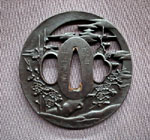 |
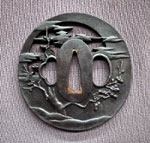 |
1)鐔 月下梅樹図 銘 萩住井上清高作
寸法:縦76.0×横73.0×厚さ6.0 (mm)
解説:菅原道真が好んだ梅は、道真を祀る天満宮にも植えられ、花咲く2月に高貴な香りを放ち、
早春の訪れを伝えている。薄明りの三日月に、透かし技法で奥行を持たせた構図。
長州藩お抱工である清高の、技術と感性の高さが伝わる。江戸時代中期-後期。保存鑑定書付。
Design of plum tree with blossoms under the crescent, made by Inoue Kiyotaka
who worked
for the Chou-shu clan (Nagato, present Yamaguchi). This is a well-composition
with depth,
his fine technique and sense of beauty can be enjoyed. It is a favorite
flower of Sugawara
no Michizane who is a great cultured noble man (9c.), its good fragrance
attracts many people.
18-19c. Hozon certificate paper.
|
2) 鐔 梅樹図 無銘
Design of plum tree with blossoms
SOLD |
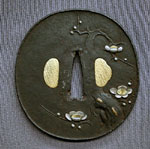 |
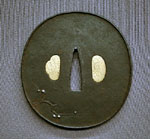 |
2) 鐔 梅樹図 無銘
寸法:縦81.0×横76.0×厚さ5.0 (mm)
余白を活かし広がりを持せた構図に、金銀色絵・銀象嵌で施された梅が引き立たてられている。
芳しい香りを今にも放ちそうな出来に、早春を感じる。江戸時代後期。
This big Tsuba have a well-composition which utilized the space. Representative flower in early spring,
plum blossoms are depicted by gold and silver plated with silver inlay.
It seems to give off a good fragrance at any moment and announces the coming spring. 19c.
|
3) 鐔 梅樹透図 銘 長州萩住河治作
Design of plum blossom by Cho-shu Hagi ju Kawaji
SOLD |
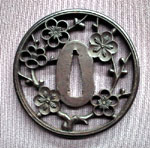 |
3) 3) 鐔 梅樹透図 銘 長州萩住河治作
寸法:縦79.0×横78.0×厚さ6.0 (mm)
解説:鉄地に梅を陰と陽で彫り、赤銅覆輪が上品な優品。長州金工の代表的一派である河治(かわじ)派の優品で
藩を挙げてその製作を奨励した長門国は、多くの鐔工を抱え、全国的に人気を博した。江戸時代中期。
保存鑑定書付。
Design of plum blossom which has been well loved from the old times, and
frequently depicted in p
ainting and poetry etc.This Tsuba has a refreshing beauty.
The blossoms are depicted with the principles of Yin and Yang,and Shakudo
cover at the rim makes
it more attractive. Kawaji is one of well-known Tsuba schools at Hagi in
Nagato (or Cho-shu),
present Yamaguchi prefecture. 18c. Hozon certificate paper.
|
4) 目貫 鬼灸療養図
Design of moxa cautery for Oni (ogre) by Kurohane School |
 |
 |
4)目貫 鬼灸療養図 水戸黒羽(無銘)
寸法:左) 縦14.0×横36.0 (mm) 右) 縦14.0×横34.0 (mm)
解説:水戸金工の黒羽派による技巧品。万病に効くとされる膝頭下の三里や背中に、お灸を据えている鬼の姿は、
豆まきの疲労回復か。鍼灸は旅の疲れを癒す松尾芭蕉も好んだと云われる。江戸時代中期。保存鑑定書付。
A scene of burning moxa on the below of knee and back which is said it’s effective
for all kinds of diseases. Oni may recover from the fatigue of Setsubun
ceremony (February 3rd). It is so unique subject made by Kurohane School in
Mito. 18c. Hozon certificate paper.
|
5) 縁頭 梅花図
Design: Plum tree with blossom
SOLD |
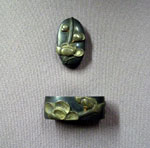 |
6) 縁頭 梅花図
寸法:(縁) 縦39.0×横24.0×厚さ14.0 (mm) (頭) 縦35.0×横19.5×厚さ10.0 (mm)
解説:梅は二月の花として寒風などの試練に耐え、年の初めに清潔な花を咲かせ、
芳しい香りを放つことから文道の神『菅原道真』をはじめ古くから多くの人に愛玩され、
詩・歌にうたわれ絵にも描かれた。江戸時代後期(19世紀)。
Design: Plum tree with blossom.
Representative flower in early spring,
plum blossoms are known by having a good fragrance and its smell attract many people.
It is an indispensable flower for people who loving the four seasons. 19th
century.
|